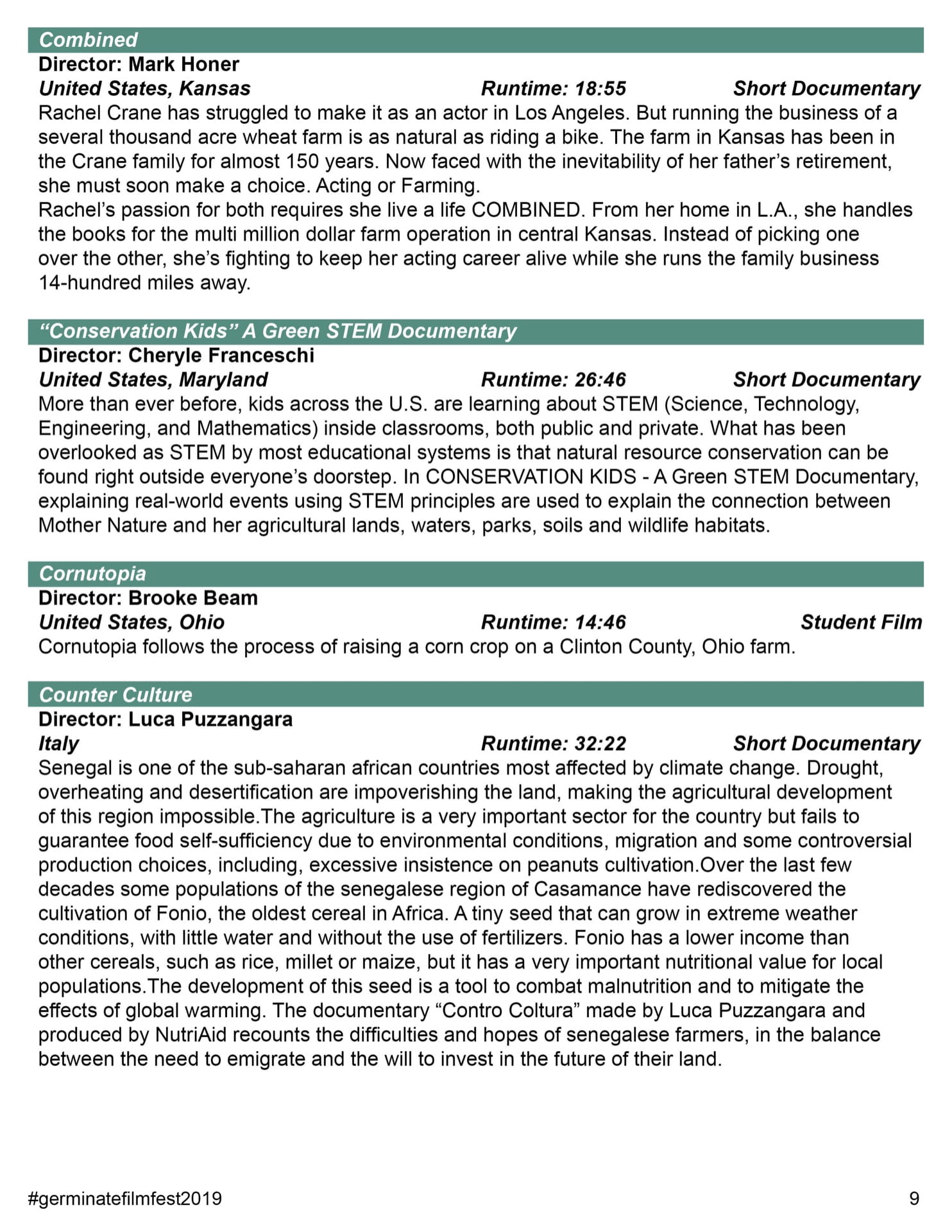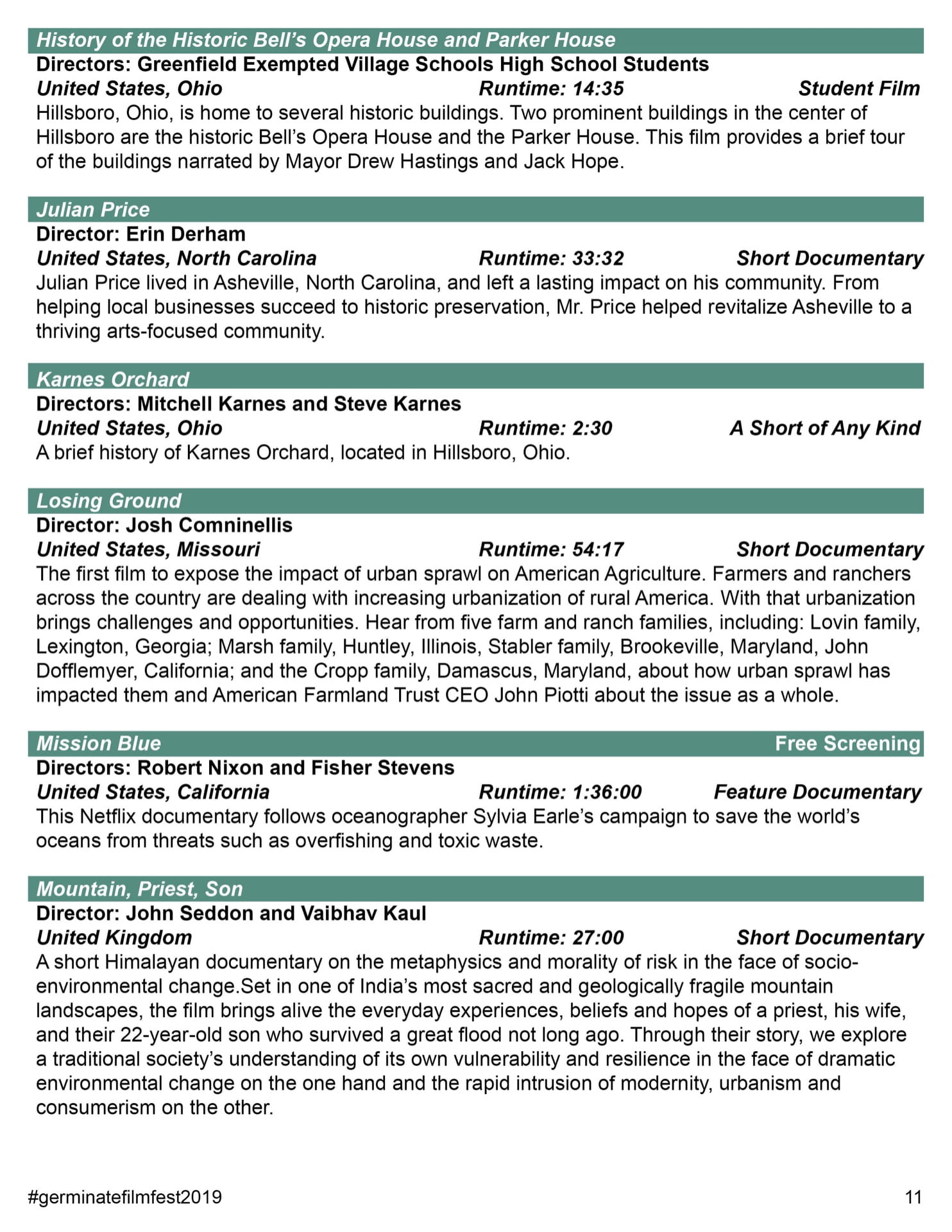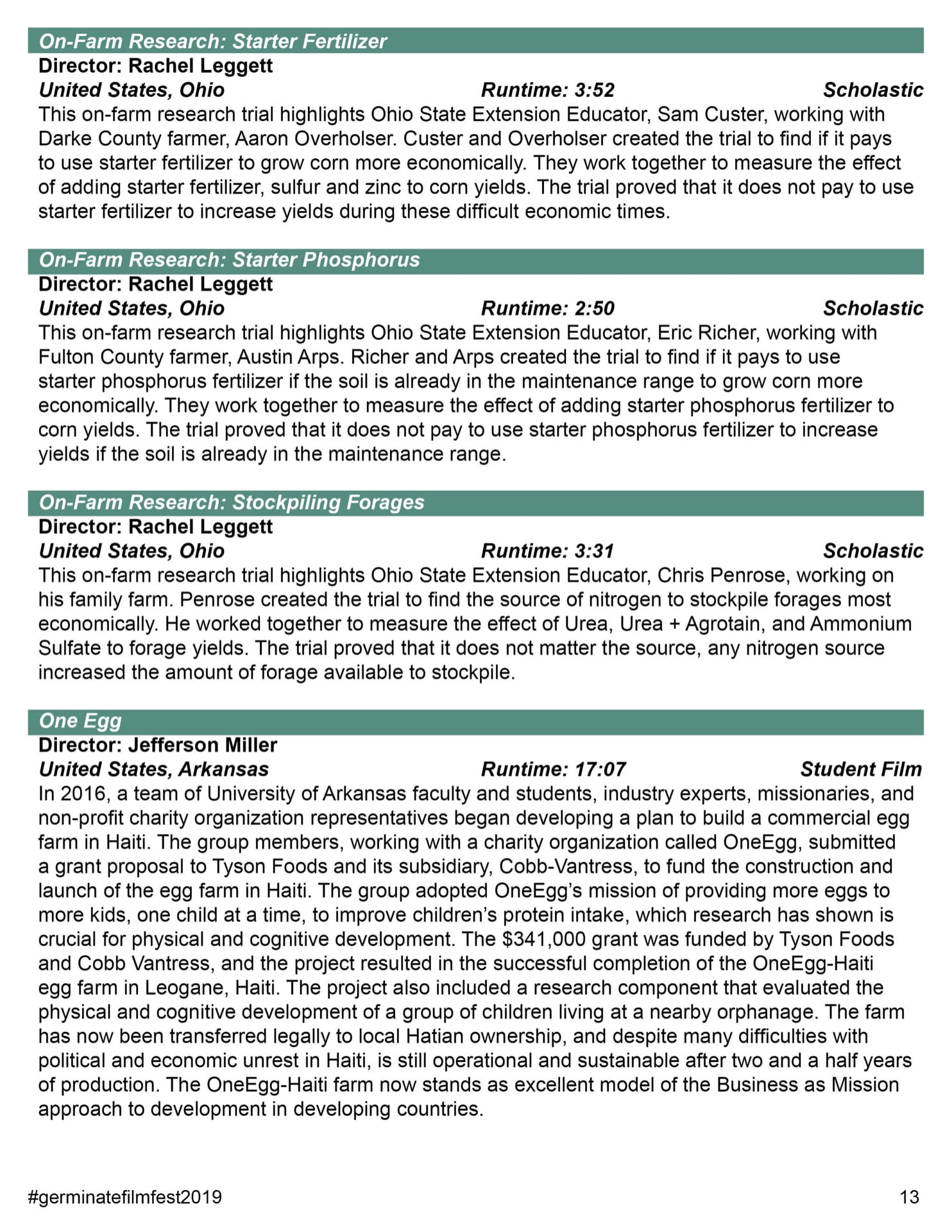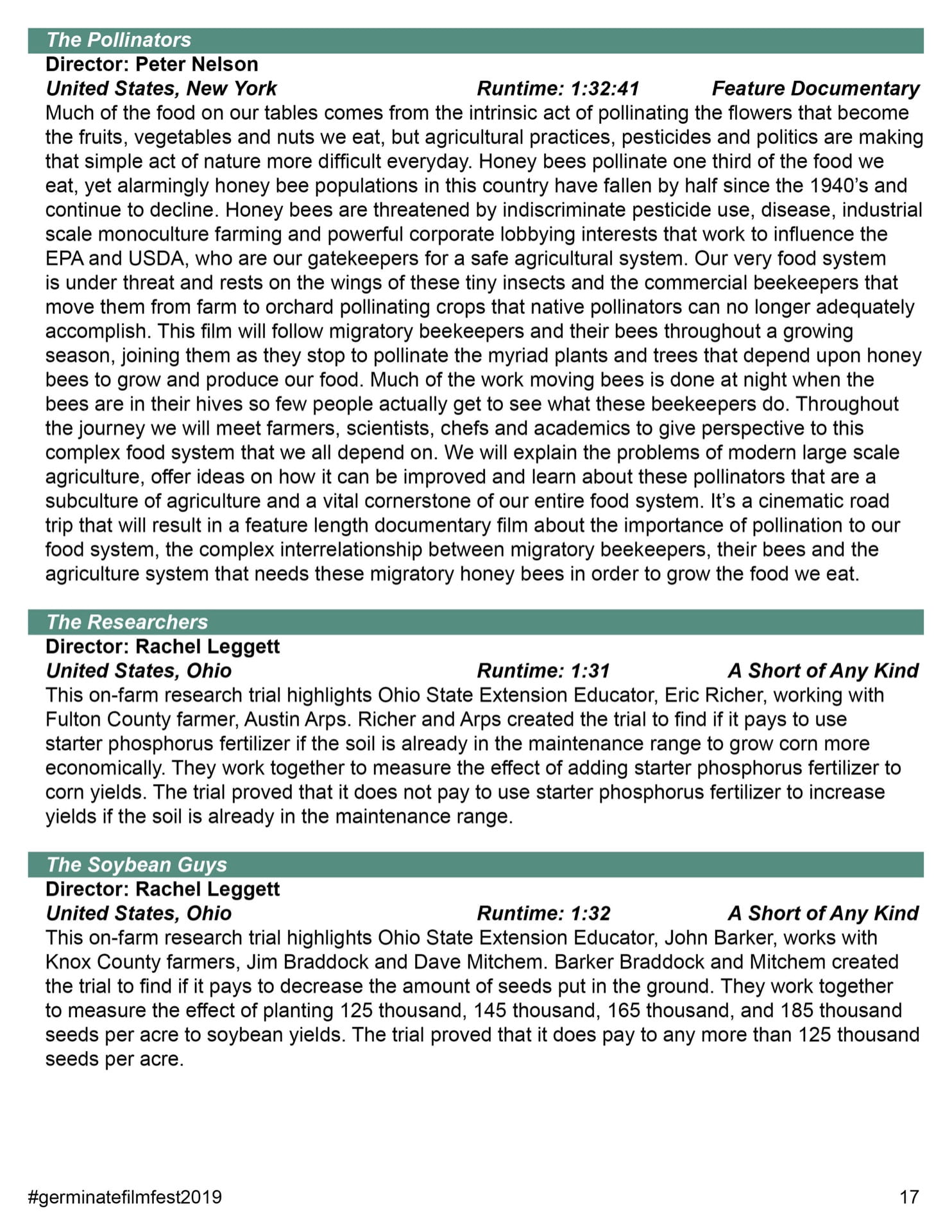As we draw closer to judgings and fair, Scrapbooking, Creative Writing and Reports are due to the Extension office by 4pm on August 1st in order to be judged. After turning in, please remember to attend interview judging on August 24th at the Jr. Fair Building. Judging schedule is available at highland.osu.edu.
Month: July 2019
Germinate International Film Fest Premiering August 16 & 17
Germinate International Film Fest Premiering August 16 & 17
Brooke Beam, PhD
Agriculture and Natural Resources/Community Development Extension Educator
OSU Extension, Highland County
July 30, 2019
The Highland County office of Ohio State University Extension is pleased to announce the inaugural Germinate International Film Fest will be held on August 16 and 17, 2019 in Hillsboro, Ohio. Germinate means to grow, and the purpose of this film festival is to grow knowledge about agriculture, natural resources, and rural communities.
Over 60 films will be shown during the film festival. Films shown range from a 90 second film by Ashton Bain, a Highland County 4-H member, to international feature length films. Topics of the films range from astronomy to water quality, and provide a new perspective on agriculture for even the most seasoned agriculturalists. Below is a list of the selected films and a description of each. Several of the films scheduled to be shown have been screened in multiple film festivals around the world and large-budget, high-quality productions. Having an opportunity to showcase this kind of filmmaking in Hillsboro is a great opportunity for all kinds of film and entertainment enthusiasts, as well as an opportunity for agricultural producers to expand their knowledge on a variety of topics relevant to their production practices.
This event will provide a forum for open discussion about agricultural, environmental, and rural community development topics important to the public. While rural areas represent 97 percent of the United States’ landmass, only 19.3 percent of the population resides in a rural area and less than 2 percent of the nation’s population identifies as farmers. This film festival will showcase the agricultural industry from the perspective of agricultural producers, researchers, and rural community members.
Rural communities face many challenges. Germinate International Film Fest has curated films that highlight the resiliency of rural communities and the individuals who are making these communities thrive. The festival fills a void and differs from thousands of other film festivals, because the films have been selected based on their ability to tell a compelling and logical story, as well as provide factual information about the topic discussed. A number of local filmmakers works will be shown, allowing attendees to connect with producers and filmmakers from the area surrounding Highland County, Ohio. Filmmakers of all skill and expertise levels have submitted films. There is also a still photography and virtual reality division.
Southern State Community College will host the screenings of the festival at its central campus in Hillsboro, Ohio. In addition to live screenings of films, attendees can participate in a series of hands-on workshops on video production, photography, agriculture, natural resources, and community development topics. The workshops will be held at various locations in Highland County, including uptown Hillsboro, Southern State Community College, and Karnes Orchard.
For more information about the festival or to purchase tickets, visit u.osu.edu/germinateinternationalfilmfest or contact the Highland County office of OSU Extension at 937-393-1918. Programs with a full schedule and list of films is available at the Extension Office.
Upcoming Programs:
Cover Crop Field Day Planned: The Highland SWCD and the Highland County Farm Bureau have partnered together to host a field day to uncover the importance of planting cover crops. The event is scheduled for August 21, 2019 from 9:30am-4pm at Brown Farms in Highland County. Information will be provided on fertilizer recommendations, the importance of improving soil health and a tour of a cover crop plot. Various events will be held throughout the day, such as in-field and an aerial seeding demonstrations. This field day will offer a unique on-site opportunity for landowners to carefully consider all cover crop options that can be implemented to advance their farming operation while capturing nutrients for a long-term investment. This field day will offer CCA Credits for Certified Crop Advisors and has a great line-up of cover crop door prize donations. Lunch will be provided with pre-registration by August 14. Please visit www.highlandswcd.com/events.html or call the Highland SWCD office at 937-393-1922 Ext 3 to register.
Germinate International Film Fest Set to Educate Viewers About Agriculture, Natural Resources, and Rural Communities On-Screen
Hillsboro, Ohio
July 24, 2019
The Highland County office of Ohio State University Extension is pleased to announce the inaugural Germinate International Film Fest will be held on August 16 and 17, 2019 in Hillsboro, Ohio. Germinate means to grow, and the purpose of this film festival is to grow knowledge about agriculture, natural resources, and rural communities.
Historically, rural communities and the agricultural industry have been depicted in entertainment media as outdated and uneducated; and they have been used as fodder for comedic material in film and television programming. However, online streaming platforms (e.g. Netflix, Hulu, Apple iTunes) have recently curated films related to food production and culinary expertise. These films represent consumers’ desire to learn more about how their food is prepared and where it is grown. The Germinate International Film Fest aggregates films that represent rural communities and their associated industries accurately, including current technologies, practices, and programs.
This event will provide a forum for open discussion about agricultural, environmental, and rural community development topics important to the public. While rural areas represent 97 percent of the United States’ landmass, only 19.3 percent of the population resides in a rural area and less than 2 percent of the nation’s population identifies as farmers. This film festival will showcase the agricultural industry from the perspective of agricultural producers, researchers, and rural community members.
Rural communities face many challenges. Germinate International Film Fest has curated films that highlight the resiliency of rural communities and the individuals who are making these communities thrive. The festival fills a void and differs from thousands of other film festivals, because the films have been selected based on their ability to tell a compelling and logical story, as well as provide factual information about the topic discussed. A number of local filmmakers works will be shown, allowing attendees to connect with producers and filmmakers from the area surrounding Highland County, Ohio. Filmmakers of all skill and expertise levels have submitted films. There is also a still photography and virtual reality division.
Southern State Community College will host the screenings of the festival at its central campus in Hillsboro, Ohio. Hillsboro is located about an hour from Dayton, Cincinnati, and Columbus. In addition to live screenings of films, attendees can participate in a series of hands-on workshops on video production, photography, agriculture, natural resources, and community development topics. The workshops will be held at various locations in Highland County.
For more information about the festival or to purchase tickets, visit u.osu.edu/germinateinternationalfilmfest or contact the Highland County office of OSU Extension at 937-393-1918.
OSU Extension believes Ohioans have the knowledge and resources they need to actively engage in creating conditions in which they thrive. OSU Extension’s mission is to create opportunities for people to explore how science-based knowledge can improve social, economic, and environmental conditions.
Steamy July Days
OSUE Brown County Master Gardener Volunteer
Margaret Roach, one of my favorite garden bloggers, describes this month by saying, “July always starts out as “Throw in the Trowel month” for me, as in: “I give up!” I want to throw in the trowel; mow the whole place down or turn it under (think: bulldozer)”.
As I gaze out the windows in the sunroom, I see at least 3 kinds of grasses growing up among the daylilies, swamp milkweed, and a few other brave perennials in the flower bed in front of my raised vegetable garden beds. It was actually “weed free” a month ago, but thanks to the spectacular rains and heat, the grasses are winning the battle! I just must remind myself that it will be ok, that the weeds can be pulled, and the mulch can be spread. Remember, we garden because we love it. I will repeat that over and over in the next few weeks.
The vegetable garden took another hit this week. The cabbages have the centers eaten out of them, and the leaves on the cucumber vines are being trimmed. I have been researching different ways to prevent future damage, but I think the first thing I will do is put out the wildlife camera and correctly identify the culprits!
One of my favorite plants in the landscape is considered a weed by some people. Common Mullein (Verbascum Thapsus) is in the Snapdragon (Scrophulariacceae) family and is a biennial. It forms a velvety-leaved basal rosette the first year and an erect flowering stem the year following.
Stan Tekiela lists Mullein’s characteristics in his Wildflowers of Ohio Field Guide as:
Height: 2 to 6 feet
Flower: Club-like spike, 1 to 2 feet long, of many small yellow flowers, ¾ – 1” wide, packed along the stalk; each flower has 5 petals that open only a few at a time, from the top down
Leaf: Large basal leaves, 12 to 15” long, with thick covering of stiff hairs, velvety to touch; upper leaves are stalkless and clasp main stem at alternate intervals; leaves progressively smaller towards top of stalk
Bloom: Summer, fall
Cycle/Origin: Biennial, non-native
Habitat: Dry, sun, fields, along roads and disturbed areas
Range: Naturalized throughout the state
Tekiela shares that Common Mullein is a European import known for its very soft, flannel-like leaves, hence its other common name, the Flannel Plant. Its dried stems stand well into winter. It is said the Romans dipped its dried flower stalks in animal tallow to use as torches. Victorian women rubbed the leaves on their cheeks, slightly irritating their skin, to add a dash of blush. Early settlers and American Indians placed the soft woolly leaves in footwear for warmth and comfort.
Start looking around to see if you have this interesting plant in your landscape! Common Mullein is a great plant and can look nice with many of our native plants like Compass plant, Cup Plant, and Joe-Pye Weed.
Remember, “The only difference between a flower and a weed is judgement!”
Good Luck to Ohio State Fair Participants
Ohio State University Extension, Highland County
Agriculture and Natural Resources/Community Development Extension Educator
July 24, 2019
The 2019 Ohio State Fair will be held from July 24 to August 4, 2019. Over the course of the fair over 100 Highland County youth will be competing at the State Fair.
Last year I made a short video highlighting a few of the Highland County participants I saw competing at the State Fair. I am hoping to create another short video again this year, so if you are competing at the Ohio State Fair on July 24, 25, or 30, send me an email to beam.49@osu.edu, let me know what you will be showing and when, and I will try to come see your show and include you in the video. If you will be showing on another day at the State Fair, email me a short video of you showing.
During the rush of spring planting this year, I assisted the Ohio State University Precision Planting Team to create a virtual reality experience for the State Fair. This VR experience highlights the advanced technology used by agricultural producers in the tractor and how farmers are partnering with researchers to improve water quality, sustainability, and efficiency in their farming operations. This VR experience will be shown everyday at the Ohio State Fair this year in the Nationwide Donahey Land + Living Building in the technology exhibit.
So if you will be participating at the Ohio State Fair, stop by the Nationwide Donahey Land + Living Building to explore a variety of agriculture-based career opportunities. Best of luck to all participants and be safe traveling to the fair. For more information about any of the Extension programs, contact the OSU Extension office at 937-393-1918.
Upcoming Events:
Leadership Highland applications will be accepted through July 29, 2019. Applications can be obtained through the Ohio State University Extension, Highland County website or by visiting the office. For more information about the Leadership Highland program, contact Brooke Beam at 937-393-1918.
Germinate International Film Fest will be held on August 16 & 17, 2019. Tickets are available now through the Ohio State University Extension Office. The Germinate International Film Fest has over 70 films and photography exhibits for attendees to view.
Foodpreneuer School Planned for September 22 and 30
Chicory and Chiggers
OSUE Brown County Master Gardener Volunteer
My husband and I love to take long drives in the surrounding areas to check the crops. The soaring temperatures have certainly put stress on everything, and we all are hoping for cooler weather and some rain. (I know, can you believe I am wishing for rain now?) I continue to water my tomatoes, cucumbers and squash every other day. The plants in the perennial bed are looking very thirsty. I try not to look their way as I carry water to the petunias planted close by.
We headed to town early this morning and we noticed the familiar bloom of the Chicory plant lining both sides of the road. When I arrived home, I headed to my favorite wildflower reference book, Wildflowers of Ohio, written by Stan Tekiela. My husband quickly commented, “Wildflower? Isn’t that a weed?” Tekiela’s information for Chicory (Cichorium intybus) includes:
Family: Aster (Asteraccae)
Height: 1-4 Feet
Flower: Stalkless sky blue flowers, 11/4 inches wide, each with up to 20 petals (ray flowers); flowers sparsely populate a tall stem and close by early afternoon; petals (ray flower) are square-tipped and fringed; color ranges from white to pink, depending upon age and location
Leaf: long, toothed basal leaves, 3-6 inches long, similar to dandelion leaves; stem leaves are oblong and much smaller, ½-1 inch long, lack teeth and clasp the stem
Bloom: summer, fall
Cycle/Origin: perennial, non-native
Habitat: dry, sun, along roads, open fields
Range: throughout
Also known as Blue Sailor or Ragged Sailor, its few flowers open one at a time and last only one day. This European import, believed to come from Eurasia, was brought to the United States to be cultivated for its long taproot, which can be roasted and ground as a coffee substitute or additive. Its edible leaves, like dandelion leaves, are high in vitamins and minerals, but taste quite bitter. Have you tried Chicory “coffee”? I have to admit that it is not at the top of my list to try!
I’m sure some of you are wondering how Chiggers fit into this story. We stopped at the farm to check on the barn painters. I walked around looking at their progress and of course I was walking in a weedy area. I am basically a chigger “magnet”, and we needed to head home to clean up ASAP. In a recent Ohio State University Extension’s edition of Buckeye Yard and Garden, it was shared that there is probably no creature on earth that can cause as much torment for its size than the tiny chigger. Tiny six-legged chigger larvae attack campers, hikers, bird watchers, berry pickers, fisherman, picnickers, and homeowners in low, damp areas where vegetation is rank such as woodlands, berry patches, orchards, along lakes and streams, and even in driers places where vegetation is low such as lawns, golf courses, and parks.
Contrary to popular belief, chiggers do not burrow into the skin. Instead, they stay on the surface of the skin and crawl to the base of a hair follicle to feed. Once settled, the larva injects the skin with digestive fluids using its piercing, sucking mouthparts (capitulum), and then they ingest the resulting “cell puree”. Some people are highly sensitive to the chigger’s feeding activity, and their skin will swell and surround the larva. This often kills the chigger, and the dead larva found within the swollen skin gives rise to the misconception that chiggers burrow into the skin.
Chiggers are usually associated with spring and early summer; however, they can undergo three generations per year in warm climates. To avoid being the victim of chiggers, avoid walking through brushy areas or wear long white pants with the socks pulled over the pant legs (quite the fashion statement, don’t you think?). Insect repellents such as DEET can help to ward off chiggers. Apply repellent to both the skin and clothing, especially to clothing openings at cuffs, neck, waistband and upper edges of socks. Follow all directions carefully. It takes several hours for the chiggers to settle, so bathing immediately after hiking in weedy areas can significantly reduce the number of bites. Calamine lotion and similar products will help to reduce itching and the risk for subsequent skin infections.
Insecticides can be sprayed to control chiggers. For the best results, target areas where chiggers are most likely to converge, such as fence rows and garden edges where shrubbery is dense. Before using anypesticide, always read the label and follow directions and safety precautions.
The bottom line for me and other chigger “magnets” is to be pro-active and use a repellent before you head out to enjoy the outdoors!
Upcoming Master Gardner Volunteer Training
Meet Our Summer Intern: Kyle Lawson
Brooke Beam, PhD, Highland County Agriculture and Natural Resources/Community Development Extension Educator
Kyle Lawson, Acre Intern
July 10, 2019
Kyle Lawson is the newest addition to the Highland and Ross County OSU Extension Offices as a 2019 Acre Intern. Lawson currently attends The Ohio State University where he is working towards his degree in Agriculture Systems Management. His past is filled with scars and stories from high school and college wrestling, where he won 3 Ohio State High School Wrestling titles. Lawson graduated from Olentangy Liberty High School in Powell, Ohio, but has moved back home to his family’s farm in Ross County. Lawson currently raises more than 20 acres of sweet corn with plans of expanding in the future. Lawson enjoys running in the countryside and runs anywhere from 3 to 10 miles a day.
This summer you can find Lawson out in the fields of Highland and Ross Counties taking soil samples for tests and managing fungicide test plots. He has already taken more than 50 soil tests for Soybean Cyst Nematodes and plans on increasing that number as the year goes on. If you are interested in having your fields tested, or for more information about this research opportunity, please contact the Highland County Extension Office at 937-393-1918.
In addition to collecting research on Soybean Cyst Nematodes, Lawson will be assisting with the Germinate International Film Fest and is developing a virtual reality experience on roadway safety for tractors. For more information about research opportunities or any upcoming programs, contact the Ohio State University Extension Office in Highland County at 937-393-1918.
Upcoming Events:
Leadership Highland applications will be accepted through July 15, 2019. Applications can be obtained through the Ohio State University Extension, Highland County website or by visiting the office. For more information about the Leadership Highland program, contact Brooke Beam at 937-393-1918.
Germinate International Film Fest will be held on August 16 & 17, 2019. Tickets will be available next week through the Ohio State University Extension Office. The Germinate International Film Fest has over 70 films and photography exhibits for attendees to view.
Tomatoes in the Home Garden
Brown County OSU Extension Master Gardener Volunteer
Leaf spot diseases of tomatoes enjoy the warm, humid weather that most of us experience in Ohio. Many of these leaf spot diseases can mimic each other in their early stages of development.
If you have access to a computer, I highly recommend visiting the Ohioline website http://ohioline.osu.edu to look at Fact Sheet HYG-1624-10. Authors, Gary Gao, Brad Bergefurd, and Bob Precheur provide readers with a fantastic list of suggested tomato cultivars to use in the home garden. Information on: Climate requirement, Site Requirements, Sunlight Requirements, Fertilization, Disease Resistance, Establishing the Plants, Plant Spacing, Supporting Tomato Plants, Growing Tomatoes in Containers, Watering Tomato Plants, Mulching, Diseases, Insects, Weed Control, Harvest and Storage, and Special Problems with Tomatoes, will help the home gardener increase their harvest.
I have received some phone calls and there are loads of photos on Facebook about spots on tomato leaves, so I am hoping this information will help gardeners determine what may be affecting their tomato plants. Proper diagnosis will help one select the most appropriate management for each disease.
*Early Blight– This is a fungal disease that can infect all above ground parts of the tomato plant. The symptoms usually begin on the leaves and start out as small necrotic (brown) spots that expand rapidly and eventually grow together, usually from the bottom of the plant, up. There is usually a small yellow halo surrounding the necrotic region. These symptoms eventually form a bull’s-eye appearance and cause leaf defoliation. Fruit symptoms include concentric rings of dead tissue, also giving the lesion a bull’s-eye appearance, these spots become large and eventually will cause fruit drop. This disease overwinters on infected plant material in the soil and seed. An OSU Extension Fact Sheet on “Early Blight of Potato and Tomato” can be found at: http://ohioline.osu.edu/hyg-fact/3000/pdf/3101.pdf.
*Late Blight– This is a fungal disease that infects quickly and can infect all above ground parts of the tomato plant. Rapid fungal development is usually enhanced by humidity and rainfall. This disease creates brown, water-soaked, or greasy lesions on stems, leaves, and fruit. Management of this disease is very important. An OSU Extension Fact Sheet on “Late Blight of Potato and Tomato” can be found at: http://ohioline.osu.edu/hyg-fact/3000/pdf/3102.pdf.
*Septoria Leaf Spot– Septoria is a fungal disease of tomatoes that affects the foliage. In some cases, the disease can be so severe that it defoliates the entire plant in a growing season causing little to no fruit production. This disease produces lesions that are usually brown, circular, and small with a yellow halo. Fungal fruiting bodies known as pycnidia can be seen usually in the middle of the mature lesion as tiny, black dots. Septoria starts on the lower leaves and works its way up the plant. Sanitation is key in managing this disease. An OSU Extension Fact Sheet on “Septoria Leaf Spot of Tomato” can be found at: http://ohioline.osu.edu/hyg-fact/3000/pdf/3112.pdf.
By now you know that the Mahaffey household loves their tomatoes. My husband wants me to hang a water-proof saltshaker on the Texas Tomato Cages so he can salt as he grazes in the tomato patch. Not a bad idea, really.
I found a great quote from Lewis Grizzard that says, “It’s difficult to think anything but pleasant thoughts while eating a home-grown tomato.”
Here’s hoping for a long and bountiful tomato season!






















